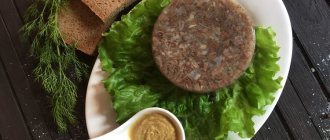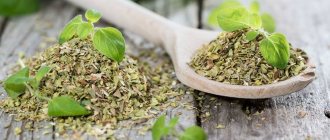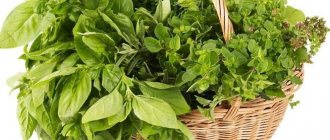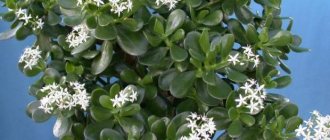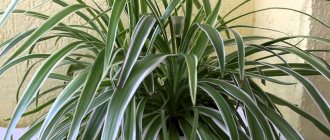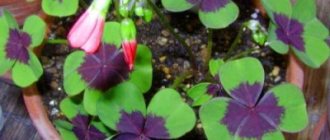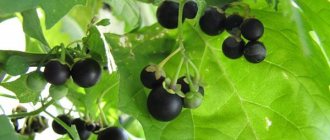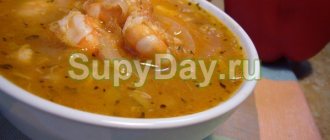What dishes are plants added to?
It is impossible to imagine Italian cuisine without oregano. It gives a characteristic taste to pizza, tomato sauce, and fried vegetables. Delicious and piquant ice cream is obtained if you put a little oregano in it. Tea is also brewed from it.
Basil and mint are used fresh or dried (read about the benefits and harms of dried basil, about drying and purchasing here). They are added to many Mediterranean dishes, when preparing fish and meat. It is recommended to add it to fatty foods, such as barbecue, to improve digestion.
To enhance the aroma of regano, put it in preparations: cucumbers, tomatoes, zucchini, peppers. Crushed dried leaves are added to dough, sauces, and are also used as one of the components of multi-component seasonings.
Uses of basil
Main uses of basil:
- cooking;
- ethnoscience;
- cosmetology.
Basil is a negative calorie product. The beneficial properties of oil and herbs are used for smooth weight loss - they speed up the metabolism in the body. Basil essential oil is poured 3 drops into salad dressings and sauces.
Greens satisfy hunger; more energy is spent on digesting them than the leaves provide.
They try to use basil in magic to attract money, ward off spirits, find love and luck, and defuse tensions in a team. To do this, they perform rituals with plant powder, leaves, or simply place the plant in a pot indoors.
In cooking
Basil has a sharp, spicy taste. Depending on the variety, it can be lemon, pepper, or clove. The spice has a strong, peppery-clove aroma, especially pronounced in hot weather. Greens can be eaten raw; young leaves are more suitable for this, they are less spicy.
Recipes using basil call for the use of both dried and fresh leaves. The latter have more useful properties. Dried spice as a seasoning is suitable for the following dishes:
- for fish – ½ tsp. for a large carcass;
- for meat – 2 pinches of dried herbs per 0.5 kg of meat;
- 1 pinch added to fish or vegetable soup will give the dish a new taste;
- legumes – 1 tsp. per 1 kg;
- vegetable salads – a pinch per 0.5 kg;
- pasta;
- baking.
When added fresh, it is added to compotes, fruit drinks, tea, and pizza.
Pesto sauce for pasta with basil:
- coarsely chop 1 bunch of basil 1 clove of garlic;
- peel 40 g of pine nuts;
- grate 50 g of parmesan;
- put in a mortar or blender bowl, add 7 tbsp. l. olive oil, salt, grind.
Tomato Sweet Basil Sauce for Spaghetti:
- pour 2 tbsp into a heated frying pan. l. olive oil, add 2 chopped garlic cloves, fry for 2 minutes;
- add 1 small bunch of basil and 600 ml of tomatoes mashed with a fork in their own juice;
- add salt, black pepper to taste, and sugar if necessary;
- bring to a boil, remove from heat;
- rub through a sieve, removing the basil and garlic;
- Cook the resulting mass for 5 minutes over low heat, stirring.
Cheese cookies with basil:
- mix 200 g, 2 pinches of salt, 15 g of chopped basil, ½ tsp each. lemon zest and baking powder;
- add 100 g butter, 1 egg, 80 g finely grated cheese, quickly knead the dough;
- refrigerate for 30 minutes;
- roll out into a layer 5 mm thick, cut into cookies;
- bake for 20 minutes at 180°C.
What does basil go with:
- with sage;
- rosemary;
- tarragon;
- mint;
- coriander;
- parsley
In dishes, basil can be replaced with the following spices:
- thyme;
- oregano;
- Provençal herbs.
To view recipes with spice:
In folk medicine and cosmetology
In folk medicine, the herbs, juice, leaf paste and essential oil of basil are used. All of them have beneficial properties. Examples:
- For dry and wet cough with laryngitis, bronchitis, tracheitis. Add 5 drops to hot tea, then drink once.
- When stressed, drink basil tea. For this, ½ tbsp. l. crushed leaves, pour 200 ml of boiling water, leave for 20 minutes. Drink 100 ml 2 times a day. You can add honey or jam to the drink.
- For sore throat. Gargle with basil decoction 3 times a day. 25 grams of leaves are poured into 200 ml of water, boiled for 10 minutes, filtered.
- For gastritis, 1 part basil oil is mixed with 5 parts olive oil, take 1 tsp on an empty stomach. within a month. The seasoning is not recommended for use in leaf form.
- Basil infusion is used in the fight against impotence. To do this, finely chop the stems with flowers and leaves, sage and rosemary, take 1.5 tbsp. l. each, pour 2 liters of boiling water and leave for 3 hours. Drink 200 ml 3 times a day.
The beneficial properties of basil are used in cosmetology. Hair Mask:
- Grind the banana with a blender;
- finely chop 20 g of black bread;
- beat the egg;
- mix everything, pour in 100 ml of milk;
- add 8 drops of basil oil;
- apply to hair, rinse after 30 minutes.
Watch a program about the use of plants for healing:
What is it: general description and features of regan grass
Basil, or its second name regan, is a spicy annual plant that grows mainly in Iran and India. Basil has played an important role in the cuisine of these countries for more than 5,000 years. Basil means “king” in ancient Greek, which makes a reference to how indispensable the inhabitants of the Mediterranean consider this plant.
This wonderful spice was brought to Europe in the 4th century AD. e. soldiers of Alexander the Great. Where does this herbaceous plant grow today? The seasoning quickly gained popularity and spread first across the Mediterranean countries, and then throughout the world.
What does the plant look like?
In appearance, basil is a branched plant, reaching an average height of 50 cm . Wild basil reaches 70 cm. Basil is characterized by strong branching. The main color of basil leaves is green, but some types of the plant often have a purple or even silver color.
The average size of the petals is 5 cm. Basil leaves are wide and oblong in shape. The inflorescences released by basil from the stems have a wide variety of colors - from pink to purple.
The stems and leaves of basil are rough to the touch - the whole point is that essential oils accumulate there. That is why almost all the time, excluding the flowering period, basil has a pronounced aroma. Basil blooms from July to September. Basil can have the most unexpected smells - it may well smell like lemon or cinnamon, depending on the variety.
You can learn more about the classification of basil by color and smell, as well as how a green plant differs from a purple one here.
What does it taste like?
Basil is widely used in cooking ; in many countries it is even considered the king of seasonings. Mainly used in dried form, added in small quantities shortly before the dish is fully cooked. Basil is highly valued because it combines with a huge number of foods: it is added to meat dishes, salads, egg dishes, pizza, and of course to fish and seafood.
What is it for?

As mentioned above, the main path of basil is cooking. It is used both in combination with other aromatic herbs and on its own. Basil is used in the preparation of one of the most popular sauces in the world - pesto. It is also included in classic dishes such as lasagna Bolognese and Caprice salad.
Basil is often used together with other herbs , for example, it is part of the well-known mixture of herbs Khmeli-Suneli. By the way, it is basil’s ability to combine with any other herbs that has made it a big favorite among chefs all over the world.
How to store regan? Dried basil can be stored for quite a long time. The most important thing is to preserve its aroma, and if you store it in a tightly closed container, it will delight you with its aromatic and taste properties for up to 6 months. Fresh basil does not stand the test of time; it is stored for only a couple of days.
In addition to cooking, basil is often used for medicinal purposes . Its medicinal properties include:
- Improving the functioning of the immune system, fighting viruses.
- Presence of antipyretic properties.
- Strengthening teeth and gums.
- Eliminating bad breath.
- Use in the treatment of respiratory diseases.
- Help in the treatment of acute heart failure.
- Good effect on the stomach for gastritis.
- Essential oils from basil are widely used in cosmetology: basil helps treat acne and also strengthens hair follicles.
- Reducing the risk of cancer.
- It is believed that basil increases stress resistance and normalizes sleep. For these purposes, it is recommended to add it to tea.
- Use for kidney diseases.
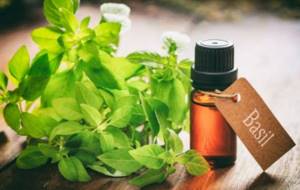
Basil juice also has healing powers. Due to the tannins it contains, it speeds up the healing of wounds and cuts. Basil juice also helps with bronchitis, the main thing is not to take more than two teaspoons per day.
Why do basil have so many benefits? Basil leaves contain a huge amount of substances with healing properties , such as vitamins:
- WITH;
- RR;
- AT 2;
- carotene;
- routine;
- camphor;
- tannins;
- large amount of fiber.
Basil stores an average of 2 percent essential oils.
Basil is also used for weight loss. To do this, brew a drink from basil seeds. Such seeds can easily be found in any pharmacy. An infusion of basil seeds is usually drunk at breakfast. Together with exercise, basil speeds up the process of weight loss.
It is worth remembering that there are contraindications:
- Not recommended for pregnant women or breastfeeding women.
- Children under 3 years old.
- Do not use if you have coronary heart disease.
- Diabetes.
- Abusing basil juice or infusions can lead to poisoning.
Delicious recipe! Sample grocery list for the week
Another unusual purpose of basil is its cultivation for decorative purposes. The plant is considered quite beautiful and is used to decorate gardens and interiors.
Spices and seasonings of Georgia and Abkhazia (video)
Nutgrass is a dried herb called blue fenugreek. This herb has a rich, spicy, nutty flavor.
Walnut grass is a national ingredient of Dagestan cuisine. Greens are added to dishes such as puff khinkal, miracles and flatbreads. In addition, the seasoning enhances the taste of meat dishes and vegetable stews.
Blue fenugreek or shamballa is an annual, spicy, aromatic plant belonging to the legume family. In different countries, the medicinal herb is called differently. The origin of the plant is India, where it is especially popular.
Residents of Germany nicknamed the nut grass fenugreek, which translated from German means “goat horn”. It’s easy to explain this name: it’s all about the appearance of the grass - curved stems and leaves that look like pods. In Russia, the herb received the name fenugreek from the word “pazhit”, which means pasture for grazing livestock.
Dried fenugreek adds a nutty flavor to dishes and goes well with meat and vegetables. If the dish must contain nuts, they can easily be replaced with fenugreek.
Walnut grass is not used in Russian cuisine, but it is popular in the former national republics: Armenia, Georgia, Dagestan.
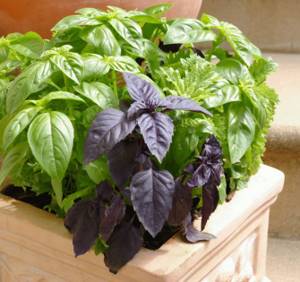
In Yemen, the main ingredient in the national dish is the nut grass. Seasoning from Dagestan and India is used in preparing dishes from different countries and peoples.
A spicy ingredient in many national dishes in the Caucasus is nut grass. The plant got its name because of its special, nutty taste. Greens are used during the preparation of various meat and vegetable dishes. Another name for the herbaceous plant is round grass, cyperus, soot mustak. Some Caucasians call the spice jimdjilim. It is worth noting that these are not all the names of this amazing plant.
What kind of plant is basil? Types, differences from other herbs and interesting facts
Basil (regan) is the name of the plant that everyone knows. Its scope of application extends from use in preparing dishes from different cuisines of the world to medicine and cosmetology. Basil was very famous in ancient times. Due to its widespread use in the field of medicine, many peoples called basil a sacred or magical herb.
Having the proud title of the main aromatic spice in the world, basil fully justifies it - because it is very common and easily accessible. It will add a spicy sophistication to any dish, and will also help improve your health. Isn't it a miracle?
Contraindications for taking oregano
The only absolute contraindication for consuming oregano is pregnancy. The use of the plant during breastfeeding is allowed in very small quantities and only after consultation with your doctor.
A natural contraindication to the use of the plant is individual intolerance, which is extremely rare.
conclusions
Oregano is an herb that has many health benefits.
It contains high amounts of antioxidants and can help fight bacteria and viruses, potentially reduce the growth of cancer cells and help relieve inflammation.
However, current research is limited to in vitro and animal studies. Further research is needed to determine potential benefits for humans.
Fortunately, oregano is universal and has almost no contraindications for use. It is easily added to your diet and can be included in a wide variety of recipes in fresh, dried or oil form.
Description and photo of thyme, thyme
Thyme, thyme is a fragrant subshrub with a creeping, woody stem, from which arise erect or ascending flower-bearing leafy branches up to 10-15 cm high, pubescent under the apical capitate inflorescence.
The leaves are cross-opposite, arranged in pairs on short petioles, small, oval, up to 1 cm long. The flowers are also small, pink-violet, with a flat upper and three-lobed lower lip, collected in a dense capitate inflorescence. They can be clearly seen in the photo of thyme below.
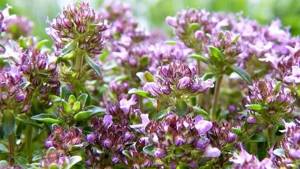
Thyme flowers
The plant blooms from June to September. It grows on sandy slopes, hills, along roads, in fields and fallow lands, in dry pine forests on the edges and between bushes. It grows in “carpet” turfs, clearly visible during the flowering period.
The herb contains essential oil (up to 0.6%), small amounts of tannins, flavonoids, ursolic, caffeic and oleanolic acids, bitterness and other substances. The composition of the essential oil is dominated by phenolic compounds (up to 60%): thymol, carvacrol, cymene hydrocarbon, as well as terpenes.
Thyme is collected during the flowering period, from late July to early September. It is best to dry your weed outdoors in the shade. The raw materials are threshed or sifted through coarse sieves. The resulting mixture should contain flowers and leaves. The smell of dried thyme is peculiar, but aromatic. The taste has a spicy, light bitterness with a barely noticeable burning sensation.
Beneficial features
Among a wide variety of spices and aromatic herbs rich in antioxidants, oregano ranks first. The phenols and polyphenols it contains can effectively counteract various harmful effects on the body's cells, including sources of threat such as cancer
The use of oregano is equally important in the prevention of diseases affecting the circulatory and cardiovascular systems.
The significant content of calcium, iron, fiber, manganese and vitamin K, as well as the essential oils already mentioned, allows this seasoning to have an inhibitory effect on the development and growth of harmful bacteria in the mouth and intestines. A successful combination of essential oils and other valuable components opens up many possibilities.
In addition, oregano:
- resists intoxication of the body;
- accelerates cell regeneration;
- is a natural antiseptic;
- has a positive effect on the nervous system;
- and, in general, due to its rich vitamin and mineral composition, it has a beneficial effect on the entire body and strengthens the immune system.
Medicinal properties of oregano
The flowers, leaves and stems of the plant contain valuable substances. About 1% of essential oil is extracted from the raw material. It has a strong odor and pungent taste. The properties of oregano oil depend on the main components:
- Thymol. Used for the production of menthol. It is used in the treatment of helminthiasis, and also as an antiseptic in the treatment of the oral cavity, nasopharynx, and as an anesthetic for toothache. Has preservative properties;
- Carvacrol. It has a bactericidal and antiseptic effect, slows down the growth of pathological bacteria. Has insecticidal properties. Oregano owes its aroma to carvacrol. In some cultivated varieties its content reaches 80%. Many well-known antibiotics and antihistamines are inferior in the percentage of oregano component;
- Sesquiterpenes. Biologically active compounds that can change their properties when heated. Regulate plant growth. They are part of anthelmintic drugs. Used as odor fixatives;
- Geranyl acetate. An ester with a complex floral and fruity aroma, used in food flavorings and perfume compositions.
The aerial part of the plant contains a large percentage of tannins and ascorbic acid. This explains the slightly astringent taste. Thanks to ascorbic acid, the herb has antioxidant activity. Tannins protect internal organs from food poisoning and their consequences, help with indigestion and flatulence. The aroma of the oil purifies the air in the room and serves as a prevention of viral diseases.
The benefits of thyme, thyme
In medicine
In folk medicine, a water infusion (decoction) or herbal tea is drunk for the following ailments:
- colds, cough, bronchitis, chest pain
- pain and colic in the abdomen and stomach, low acidity, ulcerative manifestations
- shortness of breath, swelling, as a diuretic for heart disease
- anemia, to “cleanse” the blood
- uterine bleeding, before childbirth, during childbed fever.
In official medicine, thyme is used in the production of cough syrups for colds and viruses, for bronchitis, whooping cough and other pulmonary diseases. The liquid extract is part of the medical drug "Pertussin", which is widely used in pediatrics for whooping cough and cough as an expectorant.
The second direction of thyme in medicine is almost the entire range of gastrointestinal diseases: dysbiosis, colitis, enterocolitis, etc., as a means of restoring the environment and gastrointestinal fermentation.
People with complicated hypertension, as well as during periods of high body temperature due to viral and bacterial colds, should not be treated with thyme. In all cases, you should consult your doctor.
In cosmetology
Thyme essential oil is used in cosmetology for fragrance in soaps, lipsticks, creams, toothpastes and other things. A decoction of the herb is rubbed onto the skin of the face and eyelids to relax and nourish it.
In the cosmetic industry, thyme extract is included in many lotions, ointments, and skin care creams.
At home
It’s not for nothing that the plant is called flypalm. It turns out that thyme repels moths no worse than mothballs. If you put dry thyme on clothes in the closet or hang bags with it, then insects will not damage the fabric.
In the garden
This plant is widely used in ornamental gardening for creating rock gardens. The plant is sown in small “lapins”, which grow into a flowering carpet.
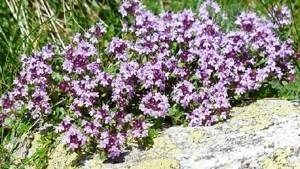
Thyme in a natural “rock garden”
In addition to the aesthetic pleasure of contemplating your man-made creation, thyme will fill the garden with a fragrant, pleasant aroma in the summer heat.
Growing basil at home
Basil is unpretentious and grows well at home on a windowsill, while retaining its beneficial properties. To speed up the emergence of seedlings, the seeds are soaked for a day in a stimulant solution (Zircon, Epin). The sowing time for home cultivation is the first half of spring, in the south – February.
The following varieties are suitable for home cultivation:
- "Freshness". Mid-season - greens can be cut 60 days after germination, lemon aroma.
- "Marquis". Mid-season, the smell and taste are sharp, mustard-pepper.
- "Dwarf". Early ripening, does not exceed 20 cm in height, grows in the shape of a ball, spicy aroma.
- "Troll". Decorative - purple leaves with a green tip, purple stem. Medium late – up to 70 days. Strong peppery aroma. Variety from the Dutch collection.
For planting, you can buy soil for indoor plants or make the soil yourself:
- garden soil - 2 parts;
- humus – 1 part;
- peat or coconut fiber - 1 part.
Read more about how to grow basil in open ground.
How to plant basil seeds at home:
- pour drainage 1.5 cm high into the pot (expanded clay, sand, pebbles), and soil on top;
- Sprinkle seed into watered furrows 2 cm deep;
- sprinkle with earth;
- cover with a bag;
- moisturize, ventilate;
- When shoots appear (after 8–12 days), remove the cellophane.
Care includes:
- watering as it dries;
- pinching the tops;
- monthly feeding with complex mineral fertilizers;
- loosening.
Watch how to grow spices in this video:
Thanks to its beneficial properties, basil helps take care of skin, hair, and normalize weight and metabolism. Its pleasant taste and aroma made the spice popular.
What recipes with basil do you know? Do you use it on your hair? Tell your friends and acquaintances about the beneficial properties by sharing this article with them.
It is used everywhere as a spice, in dried form. A small amount added to a dish makes its taste richer. That is why this spice is so loved by the cuisines of different countries; it is not for nothing that the name translates as “fragrant”. Regan herb, the beneficial properties and contraindications of which are known, is in our review today.
How to make seasoning at home
Harvesting of oregano begins during the period of its mass flowering and already from the second year of the growing season. Flowering tops are cut off. According to the rules, they are cut at a height of up to 20 cm from the soil surface.
Then they are tied into bundles and dried in the attic or somewhere under a canopy. The main thing is that the room is well ventilated. If you use modern means - dryers, then the temperature there should be no more than 40 °C.
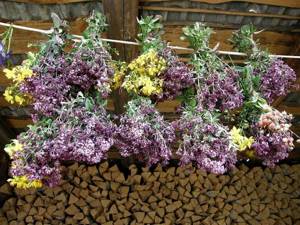
Natural drying
When drying naturally, in the attic or indoors, it is necessary to hang the raw materials so that they are not exposed to direct sunlight. Plants collected in bunches are hung upside down. If you're worried about raw materials taking up too much space, don't worry. After drying, the finished material will become almost half the size.
When the stems of the plant become dry and brittle, and the leaves fall off easily, even at the slightest touch, then the collected raw materials are ready.
In general, drying takes about a week. The longer the plant dries, the better it dries and the more flavor it retains.
All that remains is to grind the dry parts of the plant, turning them into powder. Moreover, the stems can be left for tea, and the dried flowers and leaves are ground very finely for seasoning.
It is best to separate the flowers from the leaves. The leaves are easy to collect; just run your hand along the stem and they will fall off on their own. You just need to put either a sheet of paper or a container to collect falling leaves. Now they can be ground into powder.
The powder should be stored in glass jars.
If you grow oregano in your garden, you can harvest it up to three times per season. If using fresh leaves, store them in a plastic bag in the refrigerator.
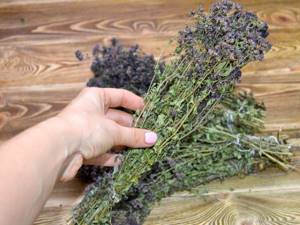
Drying in an electric dryer is good because you don’t have to spend a lot of time waiting for the grass to dry. However, if you do not have such a dryer, you can get by with a regular oven.
Oven drying
Preheat the oven. And then set the fire to the minimum value. Spread the plant evenly on a baking sheet to dry and place it in the oven. Every five minutes you need to check the drying pattern. If the plant is dry, take out a baking sheet and chop the dry leaves onto a sheet of paper. Then pour everything into a storage container.
These simple methods of drying oregano will help you prepare your own seasoning for culinary purposes.
And the video below clearly shows how to prepare oregano seasoning at home.
Thyme (thyme): medicinal properties, contraindications
The color ranges from light green to whitish, like thistle. By the way, if you have thistle growing on your property, I’ll give you a proven recipe on how to cook it - it’s very tasty! And the shape is a little different, probably some other subspecies. I use it mainly for pickling olives, but I read yours - you really should add it to meat and vegetables, it will probably be delicious. For some reason we don’t see thistles there, although the plant is not rare in our region. What parts is the dish made of? Maybe it really is a subspecies, or maybe this is the picture. Parts - you need a stem, the leaves are cut off, the white top film is peeled off with a knife, and then it is boiled with a spoonful of flour, a couple of spoonfuls of butter and a slice of lemon to remove the bitterness. And then either sauce with almonds and garlic, or chickpeas with lard and sausages are added. It turns out that this is the brother of artichokes, which is also very good for the liver and other things. But you need to know how to prepare it: Milk thistle oil, milk thistle extract (this is its medical name) has long been successfully used for the treatment of liver diseases due to the silymarin they contain - a hepatoprotector. I love thyme passionately and tenderly. Tea with thyme is generally beyond competition for me. But now I know the differences. Thyme is my favorite, I definitely add it to dishes with legumes, and to many dishes with meat. I also thought that my relatives gave me thyme in the fall. Now I look at the description, it looks like savory. When dry, it is quite difficult to distinguish them, only by smell. They gave me fresh twigs, told me to dry them and use the tops and inflorescences separately to add to tea, and to pluck the leaves “for the meat.” The leaves are elongated, with a warm aroma. The inflorescences differ in smell from the leaves. In general, I’ll check what it was. I see that seeds have poured out of the inflorescences, it will be possible to sow them on the plot. Tags aromatherapy aromaarti aromatherapy health cosmetics beauty natural cosmetics essential oil LJ Lyusya Moscow Moscow region St. Petersburg Fima aroma recipes aromatherapy lamb meat dishes poultry dishes questions and answers second courses beef mushrooms food animals for life country life snacks potatoes cosmetics cats cooking chicken curiosities vegetables first dishes chat have a laugh travel restaurants recipes fish salads pork social building a house photo barbecue show business
Read also: Silty soil near the shore 5 letters crossword clue
They say that the air of the province of Provence is so generously filled with the bright aromas of herbs that even those who were indifferent to gastronomy are ready to take up cooking! The cuisine of Provence is the most spicy of all the regional culinary trends that have developed in the country, a trendsetter in culinary fashion. Thyme, savory, basil, rosemary, tarragon, sage, oregano, marjoram. Each of these herbs has its own character, and together they merge into a single unique bouquet, known throughout the world as Herbes de Provence.
Rosemary
The shrub with the poetic name “sea dew” is the most “arrogant” of the herbs included in the Provencal bouquet: a very rich resinous-coniferous aroma is carried by dense, almost needle-like leaves. When dry, they retain their aroma just as well. Therefore, rosemary is added very carefully to prepared dishes and spicy mixtures so as not to overwhelm the other flavors. But for lamb and game, especially in the company of garlic, it becomes an excellent addition. The aroma of the plant is also interesting in combination with cheeses and grapes. And the woody shoots turn into wonderful “skewers” for grilling fish or seafood. Rosemary feels great not only in its native Mediterranean: a bush brought from Crimea will take root well in the garden, and for the winter it can be moved into a pot.
Basil
Today it is difficult to imagine Greek, Italian, French or Caucasian cuisine without the herb, nicknamed “royal” by the Greeks. In the Mediterranean, basil with green leaves is most often grown, in the Caucasus with purple leaves. Continuing our journey to the East, it is worth mentioning the “Japanese basil”, perilla: its smell is similar to basil, but it is distinguished by a slightly sharper camphor shade. For drying, you need to choose green basil: it retains its aroma much better than purple.
Thyme
The plant's Latin name thymus comes from the Greek thymiama (incense), as the ancient Hellenes used it as an incense in temples dedicated to Aphrodite. The creeping subshrub with small leaves has many more names: thyme, Bogorodskaya herb, incense, boron pepper, lemon scent... The thing is that the thyme family is quite branched. Creeping thyme is used as a seasoning for meat, fish or as a base for fragrant medicinal tea. Caraway thyme goes great with garlic and wine. More delicate lemon is a subtle seasoning for fish, seafood and sweet dishes. Thyme is prepared by cutting off the shoots with a knife or scissors. The dried bouquet is stored in a linen bag or in a glass jar.
Savory
Savory and thyme are not synonymous, although the plants are related representatives of the Lamiaceae family. Savory has a stronger peppery aroma, which is especially pronounced in combination with marjoram. The spicy aromatic bouquet of savory is complemented by a noticeable bitterness, so when using the herb on its own, do not grind it, but add whole leaves. Marjoram
A spice without which Provençal cuisine would be incomplete! It is used in meat and fish dishes, vegetable stews and soups. And besides this, it is loved by sausage producers (it gives an appetizing smell and helps cope with fatty foods), as well as by winemakers and brewers. The strong but subtle aroma of marjoram is unstable, so when using the spice on its own, it is added to the dish before cooking.
Oregano
The Slavic name for this plant, oregano, clearly indicates a strong aroma. But the Greek name for oregano is still more romantic: it translates as “the joy of the mountains.” The smell of the spice is similar to marjoram, only fuller and stronger. In addition to traditional meat and fish, oregano is good as a seasoning for mushrooms, which do not have their own distinct taste. It is best to use only oregano leaves for food, without stems or flowers.
Tarragon
The herb, also known as tarragon, is a relative of wormwood. However, the successful alliance of aromatic substances of tarragon practically does not contain bitterness, which makes it possible to prepare excellent infusions and lemonades from the plant. But tarragon must be used carefully as a seasoning for meat, otherwise the bright taste of the spice will overwhelm the other components of the dish. The taste of fresh and dried tarragon leaves is different. Some of the “green supply” can be dried, some put in the freezer: the same plant will produce seasonings with different aromatic shades.
Sage
The popular Mediterranean spice is practically not used in Ukrainian cuisine, so the plant with fluffy and fragrant leaves is known to us mainly as a medicinal one. But sage tastes so good on a plate! It goes deliciously with garlic and lemon zest, and this mixture, in turn, with fish and poultry. In cooking, it is best to use fresh sage shoots to remove after cooking. Chopped dry sage in the finished dish may taste too bitter.
Chicken in Provençal herbs
- Chicken 1.5 kg
- Onion 2 pcs.
- Garlic 3-4 cloves
- Tomatoes 2 pcs.
- Olives 200 g
- White wine 100 g
- Provençal herbs 2 tsp.
- Olive oil and butter
- Salt pepper
Divide the chicken into portions, season with salt and pepper, fry in olive oil until golden brown. Add a little butter for flavor and fry the meat for a few more minutes. Then pour white table wine into the pan and let it evaporate.
Read also: Liquid bacteria for a septic tank
In another frying pan, fry onions cut into half rings until translucent, add chopped garlic (remove the core of the clove first), olives and herbes de Provence. When the onions and garlic are slightly browned, add chopped tomatoes without skins and seeds, and simmer the vegetables for 5 minutes.
Mix chicken with vegetables, simmer over low heat for 10-15 minutes. When serving, garnish with fresh herbs.
In this review, we will look into the issue of the difference between herbs: are thyme and thyme the same thing or not. We will give a detailed answer to this question, consider the similarities and differences of herbs, and talk about their applications and beneficial properties. This article will be useful to everyone - everyone needs to know about medicinal herbs.
Uses of basil
It was used in cooking, medicine and cosmetology back in the Ancient world, sometimes attributing magical properties.
In cooking
In Asian and Mediterranean countries it is added to every fifth dish. It is used in the preparation of spicy sauces, meat and fish dishes, and is included in the list of main seasonings in Georgian, Italian, and Caucasian cuisines.
For all-season use, dried seasoning is most often used; fresh young leaves are used for salads and soups. Fresh herbs are also used to preserve vegetables.
In folk recipes, basil is included in herbal preparations to relieve coughs during respiratory and pulmonary infections. For sinusitis and sinusitis, essential oils of the plant relieve nasal congestion and accelerate the release of mucus.
A decoction of the leaves is often used to eliminate helminths from the body.
Essential oils are highly valued in cosmetology for their ability to slow down age-related changes. Basil-based creams and lotions nourish and protect the skin, reduce the harmful effects of ultraviolet radiation, and help retain moisture in the skin tissues.
At home
If an unpleasant odor has settled in the room, then you should not immediately resort to using air fresheners. It is enough to spread basil leaves on the windowsill and shelves, lightly crush them and add citrus peel to their aroma.
In the garden, the spicy plant will attract bees, increasing the number of ovaries on garden and vegetable crops, and will also get rid of many pests.
Regan has a special relationship in Caucasian cuisine - this green is one of the most common in the region. But we don’t forget about her either.
Regan harmonizes with tomatoes and dishes that include tomatoes. It is added to the recipes of salads, soups and meat snacks. Even drinks and desserts are prepared with it. Regan imparts an exquisite aroma to any meat, but the most successful combination is with lamb, which, thanks to this spice, is more easily absorbed by the body.
It is also an indispensable herb for pickling eggplants, tomatoes, and zucchini. Regan will add an unforgettable taste to tomato sauces, fish dishes, and kebabs.
It can be added to almost any dish, but it is important to consider one nuance. The spice does not like high temperatures - with prolonged heat treatment, most of the aroma is lost
Therefore, it is better to put it in dishes at the final stage of cooking.
In cooking, it is recommended to use not only fresh herb leaves, but also dried ones. When properly prepared, basil does not lose its aromatic qualities and can be stored for a long time.
Where to add thyme
In cooking, fresh leaves of aromatic herbs are used, less often twigs, as well as dry whole and ground spices.
Regardless of whether you have freshly picked herbs or dried (including ground) thyme, the proportions added to the recipe are the same.
As you know, the homeland of thyme is the Mediterranean, more precisely modern Europe, so let's start with what dishes thyme is added to in Mediterranean cuisine.
Taking into account the aromatic and taste characteristics of the seasoning, it is used in the preparation of:
- Fatty meat (lamb, pork) – baked, stewed, fried, including over an open fire
- Products and dishes made from/with meat: sausages, pates, porridges with meat Game and poultry
- Legumes (beans, peas), both separately and with meat Sauces for meat dishes
- Leaf lettuce
- Stewed vegetables, especially carrots and cabbage
These are classic dishes that are seasoned with thyme. Moreover, the true gurus of restaurant cuisine to this day operate exclusively with fresh twigs.
Goes well with marjoram, in a mixture of 1 part thyme / 3 parts marjoram, used in flavoring meat and poultry dishes, as well as sauces.
In France, thyme is an essential ingredient in the popular national mixture “Herbes de Provence,” which includes rosemary, basil, sage, peppermint, thyme, garden savory, oregano and marjoram. In Mediterranean countries, olives are pickled with thyme oil.
In Slavic cuisine, thyme is used primarily in the preparation of meat dishes: roast poultry, beef, pork, meat stew, and in marinades for kebabs. As well as brines and marinades for canning and pickling vegetables: cucumbers, cabbage, zucchini, tomatoes.
In dietetics, thyme stimulates digestive processes and accelerates lipid metabolism. This makes the spice a valuable helper for the body when it comes to fattier and heavier foods, such as meat and fatty fish.
Thyme for fish
Indeed, thyme goes well with fish. Not only fresh sprigs of thyme are added to fish dishes, but also dry powder, which, for example, when frying, is mixed with breadcrumbs or flour in a ratio of 1 to 2.
The author will tell and show how to deliciously fry fish with thyme in a video of the same name. Subscribe, like...
Thyme tea
The smell of the spice is so strong and aromatic that it cannot be confused with any other, warm and warming. Therefore, thyme tea warms and fills with energy. How to prepare an invigorating drink? Easily…
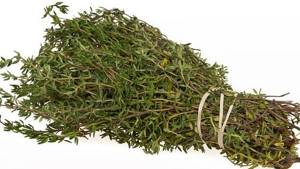
Dried thyme for tea
Universal tea recipe:
Thyme: 3-4 sprigs Just boiled: 250 ml. Favorite cup: 1 pc. Sugar or honey: to taste Preparation: put the twigs in a cup, boil water, pour boiling water over the herb, cover, let it brew for 5 minutes, add sugar and honey to taste. Ready!
Enjoy your tea!
How to replace thyme
What can you replace thyme with if you don’t have it on hand? Herbs de Provence seasoning is suitable for this purpose. The smell and aroma of thyme is similar to marjoram; if necessary, you can safely add this spice to the dish.
Garden basil is not the only one in the world
In addition to the usual regan, there are other types of it. There are about seventy of them. One of the most famous is Tulsi,
more often called Basil sublime.
Tulasi
native to India, noted in botanical reference books as Ocimum tenuiflorum.
In its homeland it is a perennial shrub. Here Tulsi
is planted as an annual.
The leaves and stem are green or purple and covered with hairs. The flowers are white, sometimes with a purple tint. The smell is characteristic of cloves. Used in cooking and Ayurvedic medicine.
Ocimum canum was introduced from Africa - camphor basil,
characterized by the smell of mint. Camphor is extracted from it and used to drive out evil spirits, and at the same time headaches, brewed as tea. This type of basil is characterized by small white inflorescences and elongated green leaves.
Basil eugenola
(Ocimum gratissimum) – grown for the aromatic substance eugenol, widely used in the pharmaceutical industry. The plant has green leaves and purple or white flowers. When used as a seasoning, it imparts a spicy peppery taste to dishes.
If in the south of Russia the crop is grown from seeds, then in the middle zone and Siberia they use seedlings. The soil should be fertile, light, freely permeable to air and moisture. Moderate watering is required.
Growing oregano
If you have a flowerbed or plot of land for a vegetable garden, you can grow oregano yourself. The seasoning will delight you on the table with its unusual aroma and spicy taste. The plant can be grown using seeds, seedlings, or dividing bushes.
Seeds are planted in prepared soil in the spring. Oregano germinates in 2–3 weeks. During this period, it is necessary to regularly water, thin out, remove weeds, and feed with mineral fertilizers. And after 2 months the plant will gain strength and will not need any special care.
It is much easier to grow oregano from seedlings. It can be planted in a flower pot or on a flower bed after a preliminary 60-day germination in special boxes with soil.
To divide the bush, it is necessary in early spring to divide the rhizome in half so that each has young shoots. Then plant in prepared soil.
Useful and harmful properties
Spicy greens have many uses. In fresh and dried form it is capable of:
- prevent seasonal vitamin deficiency;
- increase immunity;
- relieve asthma symptoms;
- relieve spasm of blood vessels and respiratory tract;
- improve blood composition;
- accelerate the removal of mucus in ENT diseases;
- regulate metabolism;
- activate intestinal motility.
The benefits of spice
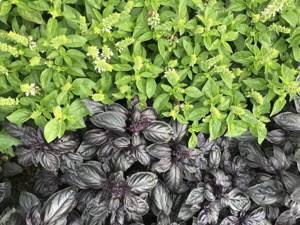
Tea with basil, cloves, cinnamon and lemon will warm you up after hypothermia and protect you from colds and viral infections.
The leaves and stems of the plant contain mercury compounds. They are useful in small quantities, but can be harmful in large overdoses.
It should not be used if you have allergies or individual intolerances.
Spice should be added to food with caution during pregnancy, epilepsy, cardiovascular disorders, diabetes, and ischemia. For hypertension and thrombophlebitis, you should consult your doctor about the amount and frequency of use of the spice

Basil greens are an indispensable ingredient in many culinary masterpieces.
What is oregano?
The oregano plant itself, or oregano, is an annual half-meter shrub. He comes from the Mediterranean region. The main countries supplying this seasoning are: Türkiye, Greece, Syria.
Originating from the shores of the Mediterranean Sea, oregano has been successfully grown in both Europe and Africa. In particular, the ancient Egyptians cultivated this plant for more than 3,000 years. In Ancient Greece, during the era called classical, this spice was widely used for both culinary and medicinal purposes. Well, oregano began to actively penetrate into other European countries from the 13th century.
Oregano has many names:
- oregano,
- amulet,
- zenivka,
- spiritual color,
- flea beetle,
- bedbugs
The name of the plant itself comes from a Greek phrase literally translated as “the joy of the mountains” or “the decoration of the mountain.” Because during flowering, oregano covers the mountain slopes with a bright, fragrant carpet. It looks very impressive and even magical. Even now, the wild variety of oregano remains quite common on the slopes of the mountain ranges of Spain or Italy.
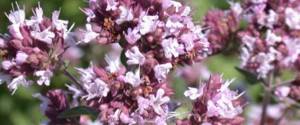
This herb has been widely used since ancient times not only as a remedy. The ancient Egyptians considered it an excellent disinfectant and preservative, and the ancient Romans mixed it with lavender and rosemary, using it to scent baths and clothes.
In fact, there is a difference between oregano and ordinary oregano:
- oregano is a wild plant, best suited for pickling and teas;
- Oregano is an excellent seasoning that is specially grown and more and more new varieties continue to be developed.
This spice has gained the greatest popularity due to its excellent combination with meat dishes, vegetables and seafood.
What's the difference between savory and thyme?
What's the difference between savory and thyme?
Download file - Savory and thyme, what is the difference
Even modern experts claim that 'thyme helps insecure, sensitive, nervous people to open up; restores strength and awakens emotions Mountain savory - Satureja montana and Garden savory - Satureja hortensis. What thyme and savory have in common is that they belong to the same family, the Lamiaceae, but in fact they are very distant relatives. If savory has a slightly similar aroma, it is only like thyme and not like other thymes, and in its absence you can, of course, replace it with thyme, but the replacement will not be equivalent and not complete, since the difference is still big. Thyme has a fresh, herbaceous-spicy aroma, while savory has a warm, spicy-balsamic, sweet-woody aroma. It opens up especially strongly during heat treatment. In herbal form the aroma is not as pronounced. The ancient Romans served savory sauce with vinegar with fish and meat dishes. Later in Europe, savory was added as a filling to veal and turkey rolls, to sauces for fish and other dishes, to sausages and pork pies. It is now used almost exclusively in combination with beans, peas and other beans. Savory combats the notorious side effect of these legumes, that is, the formation of intestinal gas. Savory helps in digesting starchy foods and heavy game. In Bulgaria this plant is bolg. Since ancient times it has been used as a seasoning in Moldavian cuisine, where it is called chimbru. It is actively used in Armenian, Georgian and Uzbek cuisine, where it is called citron, kondari and jambul, respectively. In many national cuisines it is widely used for pickling and pickling vegetables. For a long time I could not find savory in our market. And finally, after much arguing with the sellers, I found out that we should look for kondari. For a long time I demanded from my suppliers that they bring me savory. One day he catches me by the sleeve: I sniff, I don’t understand anything. He pours a handful into my hands: And there are already people around, we were still yelling and arguing. I show him this, show him that, I myself have forgotten what savory looks like. By the way, while I didn’t have it, I successfully replaced the grass with essential oil. I dipped the tip of a toothpick into a bottle of oil, and then the same tip into a pot with the same gyuvech. Since the oil is highly concentrated, drop one drop and ruin the dish. Well then, check it for yourself, and then you will say - you should have listened to an intelligent person! Something turned out long, about cumin and cumin only separately. In general, both thyme and savory are quite worthy seasonings that are worth mastering and loving. Recommend this entry Has been recommended Surprise me. Main Ratings Disable ads. Add to friends Rss. Recent Entries Friends Profile Archive Tags Memories Aromaarti - all about aromatherapy. March 31st. So, many people think that thyme and savory are either the same thing or relatives. Like cumin and cumin. These are completely different plants, just some are similar in name, others in appearance. Thyme - Thymus serpyllum - plants from the Thyme family. Another name for it is Creeping Thyme, and if it is related to anyone, it is Thymus - Thymus vulgaris. Thyme vulgaris vulgaris is also a fairly well-known plant and is widely used in cooking. Thyme differs from thyme in a richer taste and aroma. Common thyme is more delicate. Thyme improves memory and is a good antiseptic due to its chemical composition. The ancient Egyptians used thyme as one of the ingredients in the complex embalming process. They also used the herb thyme for leprosy and paralysis. The name thyme comes from the Greek thymiama incense, fragrant incense - the Greeks dedicated it to Aphrodite and burned it in the temples of the goddess. The fragrant smoke rising to the sky meant that the goddess accepted the sacrifice. It has long been believed that thyme gives courage, and another suggestion for the origin of the name is from the Greek thymon - strength. Even later, there was the Latin Thymus - strength, and Roman soldiers took baths with thyme before battle to increase vitality and courage. Scottish highlanders drank tea with wild thyme for the same purpose. Theophrastus and Avicenna also wrote about the properties of thyme, who included thyme seeds in complex medicines based on honey, vinegar, oil or wine, along with seeds of caraway, celery, parsley, mint, valerian, hyssop, asafoetida and garlic. An old Irish legend says: Buy for tokens Journal information Current price LJ Tokens Social capital Friends of Duration 24 hours Minimal stake LJT Rules View all available promo. Eco-friendly home care. Original taken from tinanovoselceva in Eco-friendly home care How we want our home to be not only cozy, but also well-groomed. For this purpose, store shelves are filled with a huge amount of all kinds of household chemicals, for all occasions, and. On the one hand, it’s good, I bought the gel for…. We have thickets of thyme along the banks of the Volga, we can harvest tons of it, and there is a lot of oregano and oregano. Reply Parent Thread Link. We harvest, but not in tons. Also fermented strawberry leaves, and a little fireweed. We grow hot peppers ourselves, more than two hundred varieties. Interestingly, I have thyme growing, but it doesn’t look like the pictures.
Read also: Pac flower fairy white splash pelargonium
Dagestan khinkal with spice
Layered khinkal is a national dish in Dagestan. To prepare it you will need the following ingredients:
- 280 grams of flour;
- 250 ml warm water;
- 1 packet of yeast (small);
- 10 grams of sugar;
- 15 grams of salt;
- a little vegetable oil.
- 1.5 kg lamb;
- 4-5 potatoes;
- 1 onion;
- nut grass and salt.
Pour flour into a bowl, add sugar, yeast and salt. Add water and gradually mix all ingredients. Leave the dough in a warm place for half an hour.
Next, the dough is divided into 3 equal parts, each of which is then rolled out. The test plate must be greased with oil and sprinkled with nut grass. A roll is formed from the plate, which is cut into small portions.
Potatoes are added to the meat broth. As necessary, remove foam from the broth.
Each khinkal is cooked separately for half an hour in meat broth. The finished dish is served in a large plate.
Pests and diseases of basil
There are about 150 varieties of regan grass. Among plants with green leaves, the following varieties are most common:
- Basilisk is an ornamental variety that does not grow higher than 20 cm. The flowers are small, white, and dense. It has a powerful spicy aroma, thanks to which it has become widespread in cooking. Cutting is carried out 2 months after the formation of seedlings.
- Greek - spherical bush 15 cm in height. It has high decorative and taste qualities. The foliage is ready for cutting 2.5 months after emergence.
- Gourmand is a plant up to a quarter of a meter high with large, wide foliage. It has good taste and pleasant aroma. Reagan greens are cut 50 days after germination.
- Thai Queen is an ornamental variety with large oblong leaves. It blooms with beautiful purple-dark flowers. The foliage is eaten throughout the growing season.
- Scamp is a plant that has small leaves with a pleasant aroma and taste. Used as a seasoning.
The main varieties of common basil with purple foliage:
- Thai is a small plant that grows in the form of a dense bush. Widely used in cooking as a seasoning.
- Opal is a variety that has bright violet-purple leaves. The flowers are crimson, they need to be picked off in a timely manner so as not to interfere with the growth of leaves. The foliage has a pleasant peppery aroma. Up to 2 kg of leaves are collected from 1 m².
- Ararat is a branching plant with lilac flowers. The smell is pleasant and powerful. Can be grown in flower pots. Cutting is carried out after 2-2.5 months from the moment of germination.
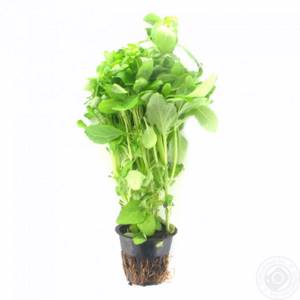
Greek basil
Most diseases of the crop in question are provoked by infectious fungi. The reason for their appearance is most often non-compliance with the requirements of agricultural technology of common basil. To combat these diseases, appropriate fungicides are used. Particularly severely affected plants will have to be dug up and destroyed.
Basil "Karakum"
The culture in question is most often affected by diseases such as:
- blackleg;
- fusarium;
- gray rot.
To reduce the risk of disease in basil plantings, you should follow the following recommendations:
- do not thicken the crops, follow the generally accepted seeding rate;
- irrigate plants in a timely manner without flooding them;
- remove weeds regularly;
- observe crop rotation and do not cultivate plants in one area for more than 3 years;
- dust the plot with wood ash weekly;
- loosen the soil on the plot from time to time.
The plant is relatively resistant to most major insect pests. In some cases, plantings may be affected by aphids or meadow bugs. They can be destroyed using insecticides.
What is the difference between oregano and basil?
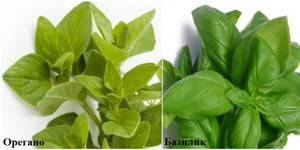
The herbs presented have a pleasant aroma due to the essential oils contained in the above-ground parts of the plants. Due to its special aroma, oregano is popularly called oregano. The plants are visually similar, but they are united by only one family - the Lamiaceae, otherwise the difference between them is obvious. To make sure whether oregano and basil are the same thing or not, you need to highlight all the differences between them.
Oregano is a perennial plant while the other plant is an annual plant. Their leaves are dark green in color and have an oblong-ovate shape with pointed tips. Based on this feature, it is quite difficult to notice the difference that it is oregano or basil. There are more than 100 species of this plant, including the purple one, which is common in garden plots.
Basil and oregano are from the same family, the Lamiaceae. Oregano has a pungent, strong taste and smell. The flowers of the plant are small, light lilac in color. Externally, it is often confused with thyme (thyme). All existing differences between thyme and oregano are presented in a separate article. While cooking, it is important to control the amount of spice added to the dish, since it may not emphasize, but greatly overwhelm its taste.

Basil, unlike oregano, has a moderate aroma and taste, piquant, slightly bitter with sweet notes. It is added to dishes at the end of cooking so that the spice does not lose its aroma during the cooking process. By smell and taste, you can easily determine what oregano and basil are. These are, first of all, spices that are used fresh and dried and emphasize the taste of various dishes. In a separate article on the site you can read about whether caraway seeds and dill are the same thing or not.
Main differences between plants
- A tasty and healthy tea is brewed with oregano, while other spices are used only as a seasoning for main dishes.
- Oregano has a more subtle, bitter, astringent taste. The basil flavor is rather pharmaceutical, with notes of cloves and bay leaves at the same time.
- Oregano and basil also differ in their distribution. The first spice is widely used in Italian, Spanish, and French cuisine, and the second - in Georgia, Armenia, Uzbekistan, and Azerbaijan.
To improve the quality of prepared dishes, it is equally important to know the difference between caraway and thyme, which are also widely used in cooking.
Basil (regan) is the name of the plant that everyone knows. Its scope of application extends from use in preparing dishes from different cuisines of the world to medicine and cosmetology. Basil was very famous in ancient times. Due to its widespread use in the field of medicine, many peoples called basil a sacred or magical herb.
Having the proud title of the main aromatic spice in the world, basil fully justifies it - because it is very common and easily accessible. It will add a spicy sophistication to any dish, and will also help improve your health. Isn't it a miracle?
Delicious recipe! Gurian cabbage recipe correct
Useful properties of seasoning
When talking about the benefits of seasoning, we first of all mean the beneficial qualities of the plant itself. Oregano is a medicinal herb and is widely used not only in cooking, but also in folk medicine.
Due to its high content of rosmarinic acid, the plant is a very valuable source of antioxidants. Oregano also contains tannins, as well as ascorbic acid. Moreover, their concentration is different in different parts of the plant. For example, flowers contain 166 mg% (milligram percent), leaves - 565, and stems - 58.
Another important component is essential oil. When obtained from the plant, it appears colorless or slightly yellowish. Thanks to this oil, the plant has antimicrobial and anti-inflammatory effects. In addition, the oil can stimulate the flow of bile. This means that digestion processes will be normal.
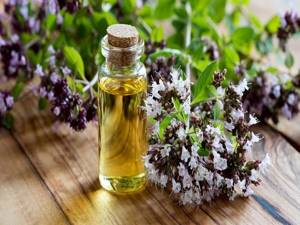
The essential oil itself is also very impressive in its composition with useful substances. It contains about 50% thymol, 12.5% carvacrol, bi- and tricyclic sesquiterpenes and up to 5% geranyl acetate. The high content of carvacrol allows the oil to surpass even some antibiotics in its bactericidal properties, and many antihistamines in its antiallergic properties.
There are a number of other beneficial properties that make oregano a very useful plant. For example, antispasmodic. Oregano can relieve spasms and reduce pain. As for pain, the oil has a good analgesic effect. As a result, it can be used in the treatment of diseased teeth and joints.
Oregano is also characterized by wound-healing properties. To heal wounds faster, you can make lotions and compresses from this herb.
Infusions and decoctions of oregano have an antimicrobial effect, neutralizing harmful microorganisms that enter the body.
Oregano also has a calming effect, helping to get rid of nervous system disorders.
The presence of fatty acids has a beneficial effect on the cardiovascular system.
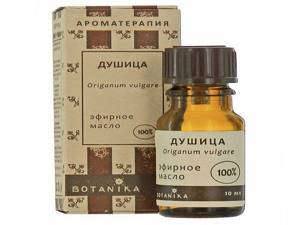
There are benefits from oregano for intestinal diseases. Its use normalizes stool, improves digestion processes, and also has a mild weakening effect.
Oregano also helps with colds and, in general, with respiratory diseases. This includes eliminating cough and using it for asthma, acute pharyngitis, tuberculosis, sinusitis and tonsillitis. To treat and prevent these diseases, not only decoctions that are taken internally are used, but also gargles.
Prepared compresses and applications from oregano can quite successfully eliminate problems associated with eczema, neurodermatitis and acne.
It has long been noted that oregano is a very useful plant for women. The use of various oregano-based products has a beneficial effect on the health of both nursing mothers and those who suffer from a lack of milk. Oregano relieves the painful effects of menstruation.
To prevent diseases of the genitourinary system, it is recommended to take oregano infusions. And during periods of menopause, oregano helps normalize hormonal imbalances.
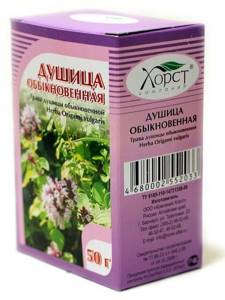
All this is due to the fact that the plant contains a large amount of vitamins, essential acids, micro- and macroelements:
- Fats - 4.28 g.
- Proteins - 9.00 g.
- Carbohydrates - 68.92 g.
- Vitamin C – 10 mg.
- Vitamin PP (niacin) – 0.7 mg.
- Vitamin A (VE) – 100 mcg.
- Potassium – 260 mg.
- Calcium – 40 mg.
- Magnesium – 30 mg.
- Sodium – 70 mg.
- Phosphorus – 50 mg.
- Iron – 0.5 mg.
- Iodine – 9 mcg.
So this plant is a fairly active medicine. However, we should not forget that, like any other medicinal substance, oregano has its own contraindications.
